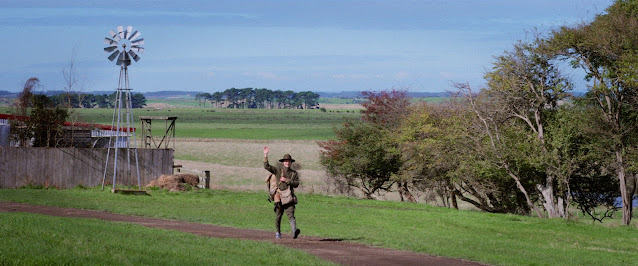
There exists a very fine line between leaving too much or too little to the imagination when it comes to horror. While
Picnic at Hanging Rock isn't exactly what is typically considered 'horror,' there can be no denying that its infamous denuement is pure existential dread, and it wields ambiguity like a weapon to create what might be one of the most compelling fictional mysteries of all time.
Picnic at Hanging Rock is, at its core, a simple story: an all-girls boarding school decides to take a trip to Hanging Rock in Victoria, Australia to have a nice picnic, which they will afterward be asked to write a short essay about. After the picnic is concluded, four girls decide to take a closer look at the rock, and everyone else, growing steadily more drowsy after their meal, let's them go on alone. Soon, three of the girls have disappeared, along with one chaperone. We're left with scant clues and next to no idea of what happened and from there the story spirals out into addressing the effect the disappearances have on the community at large and especially those left behind on that fateful date.
The story is thematically rich. It is often cryptic, and its characters aren't much more than symbols, but its vague, nightmarish vision draws us in and keeps us there all the same, even once we put it down for the night. Hanging Rock and the surrounding bush is contrasted with the boarding school and its inhabitants, illustrating the uneasy cohabitation between high society and wild country. Many fans often read colonialism into it, and many of the supernatural elements suggest inspiration from Aboriginal beliefs and practices. The girls all dress in white that day, but when Irma reappears later and addresses the student body, she's wearing crimson red, which along with the fact that everyone seems to have a schoolgirl crush on one of the other schoolgirls, suggests an erotic subtext, perhaps even a queer one. My recent forays into folk horror, especially of the Australian kind, found me noticing all sorts of parallels and connections to other works that at times made me question if one of the more mysterious girls in the party of three that vanished wasn't some kind of fairy, forest nymph, or nature spirit. Perhaps they were all murdered, abducted by a UFO, or turned into animals (the most plausible explanation, frankly.) Perhaps they simply ran away to escape their suffocating headmistress, Mrs. Appleyard, one of the book's most fascinating figures, despicable as she may be. The text leaves just enough to the imagination to allow these ideas to bloom and flourish, but it wouldn't be this good if it simply left everything up to us. There is just enough direction to make it something that is hard to shake, as you feel just on the verge of a great discovery that would blow the whole thing wide open.
Indeed, some feel they have solved the mystery, and they use a posthumously-published chapter only present in the very first draft that Lindsey cut out before ever presenting the book to publishers. To say I don't think it counts would be an understatement, but everyone else on the internet seems to believe that it constitutes a definitive end to the mystery. It's whackier and wilder than I could have expected and leaves things firmly in the supernatural category, but if the author of the book cut it before finishing the book, then it isn't an answer, period.
In terms of which is better, the book or the film, I feel that this is one of those wonderful cases where both should ideally be enjoyed alongside one another. Both include exclusive scenes and lines of dialogue, and both Joan Lindsey and Peter Weir seem to have been on an identical wavelength when creating their respective versions. The film almost edges it out in some ways simply due to its visual style, which is so in tune with the prose and imagery of the novel as to almost elevate it. Lindsey was a painter before becoming an author, and it shows in her uniquely visual approach to storytelling. That visual approach to writing a novel is a huge part of the reason why the novel is so striking and ambiguous, and the film takes this and runs with it to create one of the best-looking films I've ever seen. It really does look like a painting that has come to life. Plus, it was made in the seventies, so it possesses texture, which the recent miniseries, for example, surely throws away in favor of digital video's sleek, smooth look (though I'll admit I haven't seen it.)
Overall, both the novel and the film work just as well today as they did back in the day, all besides the publisher's boneheaded move to attempt to 'solve' the mystery years after the fact, which forever haunts the story on internet forums. After reading and watching, I was so hungry for discussion and to swap theories with others, only to find there simply isn't much chatter on the web concerning it that isn't a) based around the miniseries, b) stuck behind a paywall because its a teacher's resource, or c) some smartass pointing out that the mystery was solved
years ago. Still, disappointment at the lack of modern appreciation aside, I think this is easily one of the best novels I have ever read, right up there with Shirley Jackson's best, and the film one of the best adaptations I've ever seen. Hard to pin down, and even harder to shake off,
Picnic at Hanging Rock is one of the most fascinating works of fiction I have ever come across, and its power to unsettle and infect the imagination is quite unlike anything else, modern or otherwise. Highly recommended to everyone who is willing to give it a chance.




Comments
Post a Comment